Ultimate Guide to Choosing Your Perfect Big Couch
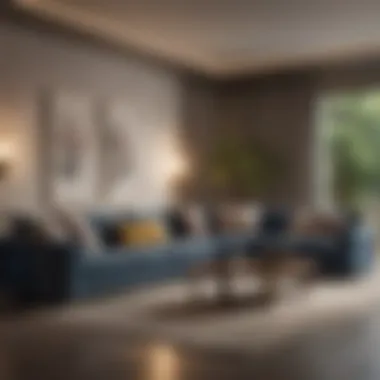

Intro
Selecting a big couch is not just about finding a comfortable place to sit. It embodies a desire for both functionality and aesthetic appeal within your living space. With the right approach, your couch can become the centerpiece of your room, reflecting your style while serving its practical purpose. This guide aims to unravel the multifaceted process of choosing the best big couch.
Understanding your preferences, space, and the latest design trends is crucial for making an informed decision.
Design Inspiration
Design inspiration plays a pivotal role when considering the ideal couch. It involves an awareness of current trends along with color schemes that resonate with your lifestyle.
Current Interior Design Trends
The landscape of interior design is always evolving. Presently, many homeowners lean towards minimalist aesthetics combined with bold accents. This trend prioritizes spaciousness and functionality, allowing the couch to serve as a versatile element within that space.
Another noticeable trend is the incorporation of vintage and retro styles. Sofas with plush fabrics, curved silhouettes, and unique patterns are gaining traction. They not only add character but can also blend seamlessly with modern decor.
Whether it’s mid-century modern or contemporary chic, factors such as material and design shape the conversations in many homes today. Would you prefer a leather couch that provides a more sophisticated edge or a fabric couch that invites cozy gatherings?
Color Palettes and Their Effects
Color selection can transform any environment. Neutrals like grays and beiges offer a sophisticated base, while deep blues and rich greens convey calmness and depth.
Bold colors can energize a space, making ample use of striking hues such as saffron yellow or fiery red can create focal points that demand attention. Remember, the colors of your couch can influence the overall vibe of the room and should be selected with intention.
Additionally, consider how different shades interact with your existing decor. Harmonizing with accents will elevate the space, making your couch feel less like an afterthought and more as part of a curated design.
"Choosing the right couch is a balance between aesthetic desire and functional requirement."
By understanding design trends and color choices, you can create a living space that not only serves its practical functions but also enhances your overall interior design.
Following this guide, homeowners can gain valuable insights that will guide them towards their ideal big couch.
Understanding the Need for a Big Couch
Selecting a big couch takes careful thought. It is often a centerpiece in living spaces. A couch sets the tone for the entire room. This section highlights the importance of understanding your needs before making a purchase. An informed choice can lead to lasting satisfaction and enhance the overall aesthetic of your home.
Purpose and Functionality
A big couch serves multiple purposes in a home. First, it provides ample seating for family and guests. Hosting events or gatherings is easier with a couch that accommodates more people. Comfort is also a priority. A cozy couch allows for relaxation and casual conversations.
Another essential aspect is versatility. For instance, many big couches are designed to adapt to different functions such as sleeping or lounging. Some may come with built-in storage. This feature can help minimize clutter in smaller homes. Therefore, considering what functions the couch needs to perform is crucial.
Furthermore, the design of the couch should match your personal style and the room’s décor. A big couch can either compliment or contrast with other furnishings. Paying attention to these details ensures that the couch works well within the living space.
- Offers seating for more people
- Provides comfort and relaxation
- Versatile for various functions
- Matches personal style and existing décor
Space Considerations
Before finalizing a purchase, it’s important to evaluate the available space in your home. A big couch can dominate a room, so size matters. Measure the area where the couch will go. Consider not only the width and depth but also the height. Clutter can easily happen if the couch is too large for the room.
In addition, consider traffic flow. A big couch should not block pathways, allowing easy access to other areas. Think about how the couch interacts with existing furniture as well. Arranging furniture for optimal space usage can impact how the room feels and functions.
It is also necessary to take note of the layout. An open floor plan may require different considerations than a more segmented space. A big couch should enhance the overall layout, creating harmonious zones for different activities, such as socializing, watching TV, or reading.
In summary, understanding the need for a big couch involves much more than just aesthetic appeal. It encapsulates functionality, space management, and personal style. Taking time to clarify these elements will make a significant difference in the satisfaction with your eventual choice.
Evaluating Size Dimensions
Evaluating size dimensions is a crucial aspect when considering the purchase of a big couch. Selecting the dimensions involves understanding both the available space and how the couch will function within that space. Improper sizing can lead to discomfort or even render the couch impractical for your living area. Therefore, careful examination of the specific elements is Essential for achieving the most satisfying results.
Measuring Available Space
When measuring available space, it's important to carry out precise calculations. Start by determining the length and width of the area where the couch will be placed. Take note of fixed elements, such as walls, doors, and windows, as these can impact the couch's placement. A tape measure can be helpful for acquiring accurate measurements.
It is beneficial to sketch a simple floor plan. This visual aid allows for a better understanding of how a proposed couch will fit into the room. In addition, consider the room's layout. Open-concept areas may provide more flexibility with placement, while smaller or more awkward spaces require careful consideration.
"Understanding your room's dimensions is the first step toward a harmonious furniture arrangement."
After acquiring measurements, it is wise to account for clearance space. Ideally, leave at least two feet of space around the couch for easy movement. This space ensures that the couch does not dominate the room nor impede foot traffic.
Choosing the Right Depth and Height
The couch's depth and height are additional important considerations. The depth determines how deep a person can sit into the couch, influencing whether it feels cozy or daunting. Deeper couches may be more comfortable for lounging; however, they can bechallenging for individuals of shorter stature.
Similarly, the height of the couch must align with your needs. Standard couch height ranges from 16 to 18 inches. A lower couch may be more comfortable for lounging or casual gatherings. Higher options can be better for formal settings or for individuals who may have difficulty getting up from a lower position.
Ultimately, choosing the right depth and height should also cater to the intended use of the couch. For example, if hosting guests is a common occurrence, ergonomics and comfort level should be prioritized. Be mindful of personal preferences and lifestyle needs, as they play a substantial role in ensuring satisfaction with your choice.
Material Selection
Material selection is crucial when choosing a big couch. The type of material not only influences the couch's aesthetics but also the comfort, durability, and maintenance involved. Each material offers distinct advantages and drawbacks that align differently with users' needs and lifestyle.
Fabric vs. Leather
Fabric couches present a diverse range of styles, colors, and textures. They often tend to be softer and warmer, making them inviting places for relaxation. Various fabrics such as cotton, polyester, and microfiber can vary greatly in price and feel.
Benefits of Fabric Couches:
- Variety of Choices: Available in countless designs.
- Comfort: Typically more plush compared to leather.
- Affordability: Generally less expensive than leather options.
However, fabric can absorb stains and odors. Regular cleaning is necessary to maintain its appearance.
Leather, on the other hand, offers a sleek and sophisticated look. High-quality leather couches can enhance the elegance of a living space.
Advantages of Leather Couches:
- Durability: Usually lasts longer than fabric couches.
- Easier Cleaning: Generally just needs a wipe down for spills.
- Luxurious Feel: Adds a touch of sophistication.
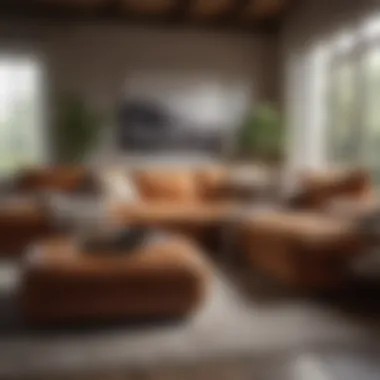
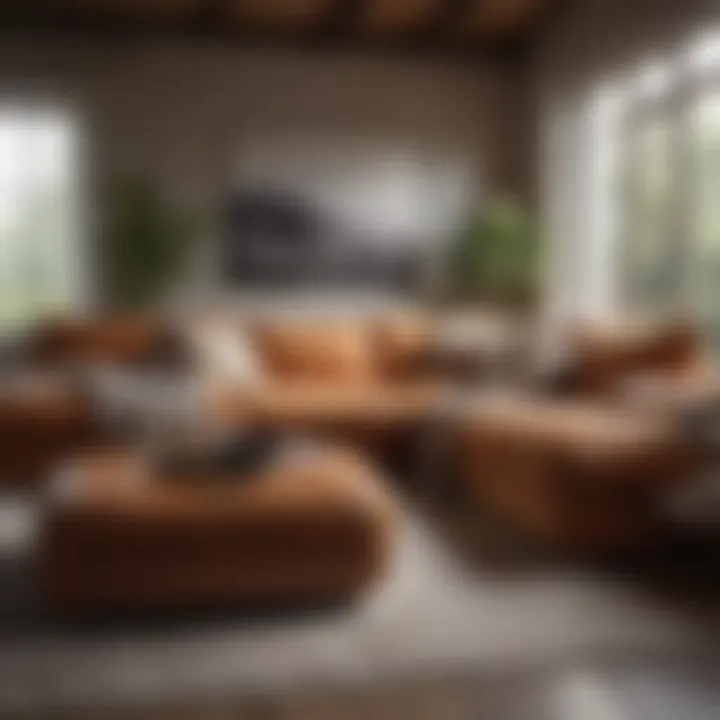
Yet, leather can be cold to the touch and may not be as inviting as fabric options. Furthermore, it often comes at a higher price point.
Durability and Maintenance
When discussing material selection, durability is often a key factor. The longevity of a couch depends significantly on its material. Fabric can wear down faster than leather, especially in high-traffic areas. Therefore, one must consider the expected usage.
Maintenance needs also differ:
- Leather maintenance is often simpler. Occasional conditioning keeps it supple.
- Fabric, however, may require regular vacuuming and spot cleaning. Selecting a stain-resistant fabric can mitigate some concerns.
"Choose your couch material based on your lifestyle. High-traffic homes may benefit from leather, while family rooms often suit fabric better."
Design Styles of Big Couches
When selecting a big couch, understanding design styles is crucial. Couches serve as both functional furniture and central aesthetic pieces in a room. Each style can influence the overall look and feel of your living space. By delving into different design styles, you can determine which aligns best with your tastes and the visual harmony of your home. Emphasizing style helps you not only enhance the beauty of your space but also ensures that the couch complements your lifestyle needs.
Modern Aesthetic
The modern aesthetic is characterized by clean lines, minimalism, and a focus on functionality. Couches in this style often feature sleek profiles without excessive embellishments. Materials like metal, wood, and textured fabrics are common choices, promoting simplicity and elegance.
Key Features:
- Color Palette: Often uses neutral colors, such as whites, grays, and blacks. Bright accent cushions may add a pop of color.
- Shape: Geometric shapes dominate, with low profiles and straight lines enhancing the modern feel.
- Functionality: Many modern couches have versatile features. For example, some include storage compartments or modular designs that adapt to different needs.
Considerations: When choosing a modern couch, consider how it fits within the rest of your decor. Ensure that the selected fabric or material aligns with the minimalist philosophy; you might want fabrics that are easy to clean and maintain.
Traditional and Classic
Traditional and classic design styles bring warmth, richness, and a sense of timelessness to a space. Couches in these styles often feature ornate details, plush fabrics, and create an inviting atmosphere. These styles may incorporate elements like tufting, rolled arms, and decorative woodwork.
Key Features:
- Color Palette: Rich colors like deep reds, greens, and blues are common, providing warmth and comfort.
- Shape: Softer and more curved shapes, with higher backs and more intricate detailing, evoke elegance.
- Materials: Luxurious fabrics such as velvet or brocade are favored, providing both comfort and sophistication.
Considerations: Traditional couches may require more care and attention to preserve the fabrics and details. Consider how your chosen couch will fit within your existing decor and balance the overall design.
Transitional Options
Transitional couches mix elements from both modern and traditional designs. This style allows for flexibility, accommodating various tastes and providing a cohesive look without being overly trendy or outdated. It strikes a balance between comfort and contemporary style.
Key Features:
- Color Palette: A mix of neutral tones with bold accent colors or patterns, appealing to various preferences.
- Shape: Combines the straight lines of modern styles with the softer elements of traditional designs.
- Materials: Utilizes both traditional fabrics and modern textures, providing diverse options.
Considerations: When opting for a transitional couch, reflect on how you can merge it with the rest of your decor. Think of ways to integrate both modern and classic elements, which can create a timeless look in your living area.
By understanding the distinct styles of big couches, homeowners can make informed decisions that reflect personal taste and enhance their living environments.
Ultimately, knowing these design styles will equip you with the knowledge to select a couch that not only fulfills your needs but also elevates your space.
Comfort Factors
When selecting a big couch, comfort factors play a crucial role. Many individuals overlook this aspect in favor of visual appeal or brand prestige. However, the comfort of a couch directly affects the overall experience in a living space. Whether hosting friends or enjoying a quiet evening, the couch should provide adequate support and coziness.
Cushion Types and Firmness
Couch cushions come in various types and levels of firmness, influencing the seating experience. Generally, there are three main cushion materials: foam, down, and a combination of both.
- Foam cushions offer great support and come in a range of densities. High-density foam is firmer and maintains its shape longer, while softer options provide a plush feel.
- Down-filled cushions offer a luxurious softness but can require frequent fluffing to fight sagging.
- Combination cushions provide the advantages of both materials, balancing comfort with support.
Understanding the firmness level is also essential. A firmer cushion supports the body better and is ideal for individuals with back issues, while softer options can provide a more relaxed sitting experience. The choice often boils down to personal preference and specific health considerations. When testing cushions, sit down for a few moments to assess how they feel.
Ergonomics and Support
Ergonomics is the study of how furniture interacts with the human body. In the context of choosing a big couch, an ergonomic design can improve comfort and reduce strain on the body.
An ergonomic couch supports the natural curvature of the spine. Look for couches that have adequate lumbar support or consider adding a lumbar cushion if needed. Additionally, the couch's depth and height are essential.
- Depth: A deeper couch allows for lounging but can be uncomfortable for shorter individuals. A shallower design may not provide enough space for tall persons.
- Height: The seat height should suit the users. A couch too low can be hard to get out of, while one too high may feel awkward.
Good support ensures that you can sit for extended periods without discomfort. This is especially valuable for gatherings where guests may spend hours in one spot.
The importance of comfort factors in selecting a big couch cannot be overstated. A well-designed couch enhances not only aesthetics but also the usability and satisfaction of a living space.
Choosing wisely in terms of cushion types and ergonomic support can elevate your sitting experience. By prioritizing these comfort factors early in your decision-making process, you are more likely to find a couch that meets your lifestyle needs.
Color and Pattern Considerations
Selecting the right color and pattern for a big couch holds weight in enhancing the overall aesthetic of your living space. This decision can alter how the room feels and looks, making it an important aspect of your interior design journey. The couch serves as a focal point, therefore its color and pattern should harmonize with the surrounding elements. Opting for a shade that reflects your style while also considering the hue of the walls, flooring, and other furniture is crucial.
A carefully chosen color can affect mood and ambiance. Soft, neutral tones create a sense of calm, while vibrant colors may energize the space. Consider the atmosphere you want to achieve before making a decision.
"The right color selection can transform a room from ordinary to inviting."
Influencing Room Ambiance
The color of your big couch significantly impacts the room's overall ambiance. Light colors such as whites, creams, and light pastels can make smaller spaces feel larger and airier. They reflect natural light more efficiently, offering a sense of openness. In contrast, darker shades such as navy blue, charcoal gray, and deep green may impart a cozy and intimate feel, suitable for larger spaces.
Additionally, brighter colors like rich red or sunny yellow can add warmth and energy to your environment. However, it is essential to balance such tones with softer accents in your décor, so they do not overwhelm the space.
Coordinating with Existing écor
When picking patterns or colors for your couch, ensuring they align with the existing décor is vital. Evaluate the colors present in your room, such as in art pieces, curtains, and other furniture. A cohesive look can be achieved by opting for colors that complement or contrast effectively without clashing.
Consider the following:
- Patterns: If your room has a lot of patterns, a solid-colored couch may provide visual relief. Conversely, if the space is mostly plain, a patterned couch can add interest and texture.
- Match or Contrast: Decide whether you want the couch to blend in with its surroundings or stand out as an accent piece. This can influence both your color choice and the pattern selection.
- Theme Consistency: Keep in mind any design themes you've adopted in your home. A modern couch may clash with a traditional décor style, so ensure that the couch remains within the theme you’ve set.
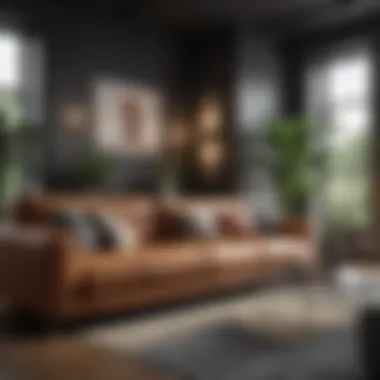
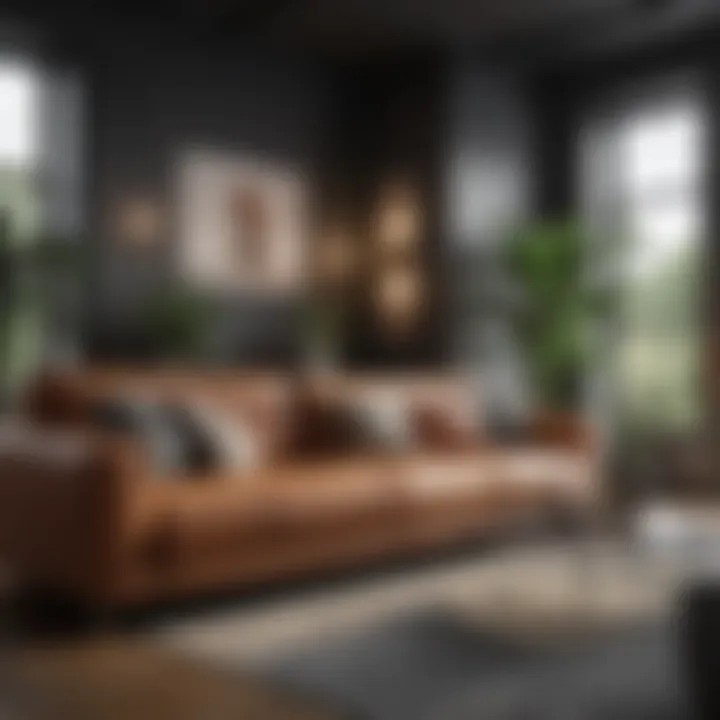
Sustainability Aspects
When considering the purchase of a big couch, sustainability is a significant aspect that should not be overlooked. The environmental impact of furniture manufacturing frequently affects quality, safety, and comfort. Opting for eco-friendly options allows consumers to make choices that benefit both their immediate surroundings and the planet.
Eco-Friendly Materials
Material selection is critical when sourcing a sustainable big couch. Many manufacturers are now offering furniture made from alternative, eco-friendly materials. These include:
- Recycled Fabrics: Using reclaimed textiles reduces waste and resource consumption.
- Bamboo: This fast-growing plant is a renewable resource and can be a sturdy frame option.
- Organic Cotton: Grown without harmful fertilizers and pesticides, organic cotton is another safe and sustainable choice.
- Plant-Based Foams: Many couches utilize foams made from soy or other plant materials, lowering dependency on petroleum-based products.
Using these eco-friendly materials not only lessens the carbon footprint but also ensures a healthier home environment. When seeking a big couch, look for certifications such as Global Organic Textile Standard (GOTS) or CertiPUR-US to guarantee the materials used meet sustainability criteria.
Long-Lasting Investment
Investing in a sustainable big couch also provides long-term benefits. A well-crafted piece made from durable materials tends to last longer, thereby reducing the need for frequent replacements. This longevity contributes positively to the environment by minimizing waste.
The cost saved over time through reduced replacements can significantly outweigh the initial price difference between a sustainable couch and a conventional one. In addition, many eco-friendly brands ensure that their products are made under fair labor practices, aligning your purchase with ethical standards.
In summary, focusing on sustainability when choosing a big couch comprises more than just selecting eco-friendly materials. It encompasses the entire lifecycle of the product. An astute choice can provide aesthetic beauty, comfort, and environmental stewardship for years to come.
Investing in sustainable furnishings is a commitment not just to style and comfort, but to the health of our planet and future generations.
Budgeting for a Big Couch
When considering the purchase of a big couch, understanding how to budget is essential. An effective budget can prevent overspending and ensure that you choose a piece of furniture that meets both your aesthetic desires and functional needs. While a big couch can significantly enhance your living space, it is crucial to align your choices with financial realities. This ensures you make a wise investment with long-term value rather than succumbing to impulse buying or trends that may swiftly fade.
Setting a Realistic Budget
Setting a realistic budget involves evaluating how much you are willing to invest in a significant piece of furniture like a big couch. Begin by assessing your current financial situation and identifying how much you can allocate without straining your finances. It's important to consider not only the price of the couch itself but also potential additional costs such as delivery, warranties, and even maintenance of the couch over time.
Consider the following factors when determining your budget:
- Couch Type: Different couch types, such as sectionals, loveseats, or sleepers, vary in price. Knowing what style you want helps narrow down options.
- Material Choices: Leather couches tend to be more expensive than fabric couches. Understand the trade-offs between durability and initial costs to make a balanced decision.
- Brand Impact: Established brands may carry higher prices due to quality assurances, while lesser-known brands might offer a more budget-friendly alternative.
- Sales and Discounts: Don’t overlook seasonal sales or clearance events that can significantly reduce the price of a couch you admire.
Assessing Long-Term Value
After setting a budget, the next step is to assess the long-term value of the big couch you are considering. This entails evaluating various aspects of the couch that affect both its immediate satisfaction and its durability over time.
Focus on these key elements:
- Durability: Look for high-quality materials that can withstand wear and tear. Leather, for instance, can last longer than fabrics with proper care. Examine warranties as they often reflect the manufacturer’s confidence in their product.
- Functionality: Assess how the couch fits into your lifestyle. A couch that serves multiple purposes, like a sleeper couch, may offer greater value despite higher upfront costs.
- Maintenance Requirements: Consider how much effort and cost will be associated with keeping the couch in excellent condition. For example, certain fabrics require more consistent cleaning and care than others.
- Timeless Style: Opting for a design that remains appealing over the years can save you money. Trends change, but a classic design can adapt to various settings and avoid the need for an expedited replacement.
"Investing in a big couch is not merely a purchase; it’s a long-term decision impacting both your finances and your comfort."
By carefully evaluating these aspects, you can ensure that your budget not only accommodates the initial expenditure but also supports ongoing value and satisfaction. This balance between immediate cost and long-term benefits is crucial for making an informed decision about your big couch.
Shopping Tips
When it comes to selecting a big couch, informed shopping is crucial. This section provides practical guidance on how to navigate the diverse market of couches. Understanding what to look for can save both time and money. It allows buyers to make choices that align with their needs and preferences, ensuring satisfaction in the long run. By adopting effective shopping strategies, homeowners and design enthusiasts can find a couch that enhances their space while also offering functionality and comfort.
Researching Brands and Store Options
Before making a purchase, it is essential to conduct thorough research on the various brands and stores available. Different manufacturers have reputations, specialties, and pricing strategies that may influence your choice. Look for brands known for quality and excellent customer service. Read customer reviews to gauge product satisfaction and issues related to delivery and assembly.
Consider visiting established furniture retailers like IKEA, Ashley Furniture, or West Elm, as they often provide a range of styles and price points. Online shopping platforms such as Wayfair or Amazon also offer convenient options and customer feedback.
Here are some important factors to consider during your research:
- Product Quality: Look into materials used in construction and finishes. A high-quality couch lasts longer.
- Return Policies: Understand the store’s return policy in case the couch does not fit or function as expected.
- Warranty Information: Check the coverage offered on your purchase. A good warranty indicates confidence in the product’s durability.
- In-Store Experience: If opting for a physical store, focus on the layout and customer service.
Test Driving the Couch
After narrowing down the options, the next step is to physically test the couches. This phase is critical. Sit on the couch to assess comfort levels, firmness, and overall feel. Pay attention to cushioning and back support. It is advisable to spend several minutes or even longer on the couch, as it helps simulate actual use.
Focus on these elements when test driving:
- Comfort: Ensure the couch feels inviting. Is it too soft or too firm for your liking?
- Height and Depth: Make sure the height allows for easy sitting and getting up. Depth should accommodate your body size comfortably.
- Construction: Check the frame structure by examining its sturdiness. Rocking or excessive movement may indicate poor construction.
Remember:
"The best choice is often built on hands-on experience and personalization."
Testing couches can reveal significant aspects that online descriptions may not convey. Taking these deliberate steps in the shopping process can lead to a more satisfying purchase that meets both functional and aesthetic needs.
Placement Strategies
Placement of a big couch is a crucial consideration in maximizing the functionality and aesthetics of a living space. The right placement can create a welcoming atmosphere while ensuring comfort for its users. Moreover, effective placement strategies can enhance the design flow in a room and facilitate better movement. To achieve this, careful thought must be given to how the couch interacts with other elements in the area.
Arranging for Space Efficiency
When arranging for space efficiency, the aim should be to use the room's dimensions wisely. Knowing the available space before choosing where to put the couch can avoid clutter and overcrowding. Take measurements of the room and the couch to find the best fit. Positioning the couch against a wall often helps to create a feeling of openness in the center of the room. This setup allows for better circulation and can make a room feel larger than it is.
Consider opting for an L-shaped couch if space is limited. This design can fit snugly into corners, utilizing every inch of your living area. Furthermore, making space efficient goes beyond just the layout of the couch itself. Think about other furniture pieces. For example, placing a coffee table within reach can enhance usability without complicating movement around the space.
Creating Functional Zones
Creating functional zones within a room can greatly enhance the usability of space. In a multi-purpose living area, for instance, a big couch can act as a divider between different zones, such as entertainment, conversation, or reading areas. Using rugs or distinct lighting can aid in demarcating these zones while maintaining a cohesive look.
For example, place the couch to face the TV for a cozy media zone and use stylish side tables to elevate functionality. The couch could also be oriented to face a window or fireplace, enhancing the social aspect of the room. This positioning can encourage interaction among users while also ensuring they enjoy views outside or a warm glow from the fire.
This demonstrates how careful placement can encourage social interaction and optimize comfort within the space.
In summary, the placement of a big couch plays a significant role in defining how a living area functions. By considering space efficiency and creating functional zones, individuals can craft spaces that are not only stylish but also practical.
Trends in Big Couches
In today's market, trends in big couches are a vital aspect to consider when selecting the right piece for your home. Keeping up with these trends helps buyers make informed choices that can enhance both style and functionality in their living spaces. Fashion in furniture evolves, and understanding current styles allows for better integration with existing decor.
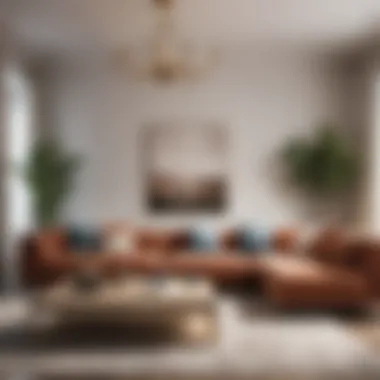

Benefits of Following Trends
- Aesthetic Appeal: Contemporary designs often showcase clean lines and minimalist forms, appealing to modern sensibilities.
- Versatility: Trends can dictate adaptability, making it easier to find pieces that fit unique layouts and functions.
- Innovation: New features introduced through trends may enhance comfort and convenience.
Navigating these trends can lead to a big couch that not only fulfills basic requirements but also meets aesthetic aspirations. Collaborating with design enthusiasts can further guide choices.
Popular Styles Currently
Current popular styles in big couches reflect a mix of modern, industrial, and traditional influences. Some notable trends include:
- Mid-Century Modern: Characterized by sleek lines and organic shapes, mid-century couches evoke nostalgia while offering modern comfort.
- L-Shaped Sectionals: These remain a staple for space efficiency, providing ample seating while fitting neatly into corners or large living areas.
- Chesterfield Sofas: Classic yet trendy, these sofas feature tufted upholstery and rolled arms, adding a touch of sophistication.
Buyers appreciate the blend of functionality and aesthetic that these styles present. Selecting a popular style ensures that your big couch will stay relevant, meeting both comfort and decor needs for years to come.
Innovative Features
Innovation in couch design focuses on enhancing user experience while addressing modern lifestyle demands. Some features to consider include:
- Adjustable Sections: Some big couches now allow for various configurations, adapting to the specific needs of a gathering or an individual’s preferences.
- Built-In Storage: Cleverly designed couches with hidden compartments offer practicality without sacrificing elegance, making them suitable for smaller spaces.
- Smart Technology: Today's big couches may include features like USB charging ports and integrated speakers, blending functionality with entertainment.
"The best designs cater to both form and function, creating an inviting and practical living space."
Incorporating these innovative features can reshape how you utilize your couch, making it not just a piece of furniture, but a central element of your home. Homeowners and enthusiasts alike find value in couches that transform how they socialize and relax.
Case Studies
Case studies provide an essential framework for understanding how consumers engage with big couches in real-world settings. They illustrate practical applications, shedding light on the impact of various purchasing choices and design decisions. Analyzing case studies reveals common patterns and valuable insights that can inform prospective buyers about what to expect when integrating a sizable couch into their own spaces. These real-life examples help to demystify the selection process, making it clearer and more relatable.
When examining case studies, several specific elements come to the forefront. These include spatial dynamics, design aesthetics, and user experience. Not only do these aspects highlight the functional integration of big couches but they also demonstrate how personal tastes and lifestyle needs shape the final purchasing decisions of homeowners and interior enthusiasts.
The benefits of including case studies in the discussion of big couches are manifold. They can articulate the successes and challenges that come with different couch styles and layouts. Furthermore, they reveal how the right couch can enhance comfort, support social interactions, and elevate the overall ambiance of a living space.
Considerations should be made in selecting appropriate case studies. Key factors such as variety in styles, usage contexts, and audience demographics are important for a comprehensive understanding. The goal is to offer a panoramic view of how diverse couches live within varied environments, thereby addressing a wide spectrum of reader interests.
"A well-chosen couch not only serves as a seat but becomes a central piece of the home, reflecting personal style and functional needs."
Successful Big Couch Integrations
Successful integration of big couches often hinges on creating a harmonious balance between functionality and design. Analyzing specific case studies reveals strategies that homeowners have used effectively. These examples often showcase how a big couch can serve multiple roles, from a lounging area to a place for hosting gatherings.
Homeowners frequently emphasize the importance of scale. For instance, in a compact living room, a sectional couch can maximize seating while minimizing visual clutter. Further, they sometimes opt for modular designs, allowing them to reconfigure the space according to their changing needs.
Designers often suggest ensuring coordination with surrounding elements. This means considering how the couch fits with existing furniture and decor. Homeowners may select colors and textures that enhance the overall theme of their rooms, ensuring the couch complements rather than clashes with its environment.
Before and After Comparisons
Before and after comparisons serve as powerful testimonies to the transformative impact of a big couch in a living space. Observing these transitions helps potential buyers understand the scope of change that a carefully chosen couch can bring.
A common theme in such comparisons is the shift from a cluttered or sparsely furnished area to a welcoming, cohesive environment. For example, a simple living room may feel disjointed prior to the addition of a big couch. Afterward, it often showcases improved flow and comfort, inviting social gatherings and relaxation.
These case studies can reveal useful insights about color choices, texture variations, and layout adjustments. Comparing photographs or descriptions of spaces pre- and post-couch reveals not only aesthetic changes but also functional improvements. They encapsulate the notion that the right big couch is not just a purchase; it is an investment in lifestyle enrichment and visual appeal.
Handling Common Issues
When it comes to selecting a big couch, addressing common issues is crucial. Many homeowners encounter challenges that can affect their overall satisfaction with their purchase. Understanding these common pitfalls can save time, frustration, and additional expenses. It is important to tackle specific considerations like sizing dilemmas and fabric durability to make informed decisions.
Addressing Sizing Dilemmas
Sizing dilemmas often arise during the selection process. A big couch needs to fit well within the given space while still keeping the room functional and not overcrowded. Here are some key steps to help navigate this issue:
- Measure Your Space: Before shopping, take accurate measurements of the area where the couch will be placed. Consider the length, width, and height of the space.
- Consider Room Layout: Think about the arrangement of other furniture in the room. A large couch should complement the existing layout, enhancing comfort and aesthetics.
- Proportionality: A couch should maintain proportionality with the room size. A very large couch in a small room can appear overwhelming, while a small couch in a large room could seem lost.
- Visualize with Tape: Using painter's tape to outline the couch's dimensions in your space can provide a clearer understanding of how it will fit.
Taking these factors into account will lead to better choices regarding sizing, ultimately making your experience more enjoyable.
Dealing with Fabric Wear and Tear
Durability is an essential consideration when selecting a big couch, especially regarding fabric wear and tear. Different materials behave differently under various conditions, so it is vital to choose wisely.
- Fabric Type: Some fabrics are more resilient than others. For example, microfibers or synthetic blends often resist stains and wear better than lighter fabrics like cotton or linen. Leather also offers durability but requires proper care.
- Lifestyle Factors: Consider your lifestyle when choosing fabric. If you have pets or small children, opt for materials that can withstand additional wear and tear. Look for options with protective coatings that resist stains and scratches.
- Regular Maintenance: Proper care can prolong the life of your couch. Regularly vacuum the fabric to remove dust and debris. Promptly address any spills to prevent stains from setting.
"When choosing a couch, consider how it fits into your life. Quality materials can save money in the long run by reducing the need for replacements."
- Repair Options: Understanding your couch's warranty and repair options helps handle potential damage quickly. Fabric repairs can often be less expensive than replacing the entire couch.
In summary, by addressing sizing dilemmas and understanding fabric durability, homeowners can avoid common issues when selecting the best big couch for their needs. This informed approach will enhance both comfort and style in any living space.
Maintenance and Care
Maintenance and care for a big couch are crucial for its longevity and appearance. A large couch often serves as the centerpiece of a living area, making it essential to keep it in good condition. Regular maintenance not only enhances the aesthetic appeal but also supports the structure and comfort of the couch. A well-maintained couch can last for years, providing comfort and style without the need for premature replacement.
Cleaning Recommendations
Regular cleaning of a big couch helps in preventing the buildup of dirt, dust, and allergens. Here are some essential cleaning tips:
- Vacuum Regularly: Use a vacuum attachment designed for upholstery to remove loose dirt and dust. This is important, especially in high-traffic areas.
- Spot Cleaning: Address stains and spills immediately. Blot liquids with a clean cloth without rubbing. For solid stains, scrape gently with a dull knife before cleaning.
- Use Mild Detergents: Make a solution of mild soap and water for cleaning your couch. Test any cleaning solution on a hidden area first to avoid damage.
- Professional Cleaning: Consider hiring a professional upholstery cleaner once every few years to give your couch a thorough cleaning and restore its original luster.
Preserving Color and Texture
Maintaining the color and texture of a couch is necessary to keep it looking fresh. Fabrics can fade or wear due to sunlight exposure and regular use. Follow these steps to maintain the vibrancy and texture:
- Avoid Direct Sunlight: Position your couch away from direct sunlight. If that's not possible, consider using window coverings to prevent UV damage.
- Use Fabric Protectants: Apply protectants that are specifically designed for upholstery. These can help repel stains and dirt while preserving the fabric's color.
- Rotate Cushions: Regularly rotate cushions to ensure even wear and prevent sagging. This helps maintain their shape and prevents one side from fading faster than the other.
- Dust and Brush: Regularly dust your couch with a soft brush or cloth. This helps remove dust and debris that can dull the fabric.
Proper maintenance and care are fundamental to ensuring that your big couch remains an inviting and visually appealing part of your home. Investing time and effort into these practices pays dividends in comfort and beauty.
Culmination
In the process of selecting a large couch, the conclusion serves as a vital summarization of previous discussions in the article. The importance of understanding a well-rounded perspective on all factors cannot be overstated. Selecting the best big couch is not just about aesthetic appeal but also involves practicality, comfort, and long-term benefits.
When considering your choice, reflect on the intricacies of size and dimensions. Knowing the spatial limitations and how these factors influence functionality allows you to navigate your options more effectively. Material selection, whether fabric or leather, impacts not only the look but also the durability and maintenance level of the couch, underlining the necessity of making an informed decision. Moreover, knowledge of design styles further enables individuals to achieve a cohesive feel in their living spaces, ensuring synergy with existing decor.
Recapitulation of Key Points
- Understand the purpose and functionality of the couch in your space.
- Evaluate size dimensions, ensuring it fits seamlessly in the designated area.
- Choose appropriate materials that will withstand daily use while maintaining style.
- Identify design styles that resonate with your personal aesthetic and harmonize with other elements in the room.
- Consider comfort factors such as cushion types and ergonomics.
- Select colors and patterns that enhance the overall ambiance of the environment.
- Account for sustainability to promote eco-friendly practices in your purchase.
- Budget realistically to find a couch that offers both value and quality.
- Utilize shopping tips to navigate the market effectively and ensure an optimal buying experience.
- Implement proper maintenance techniques to prolong the life of the couch.















